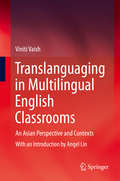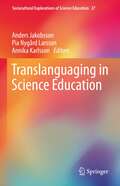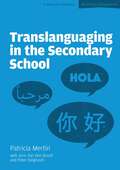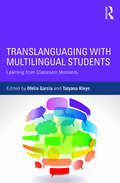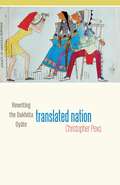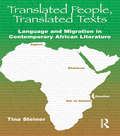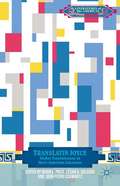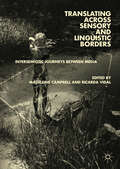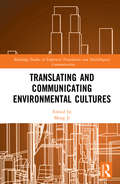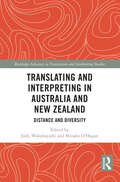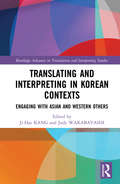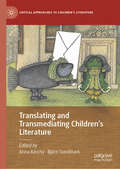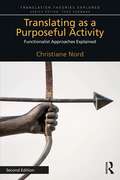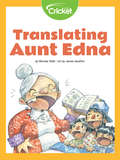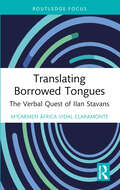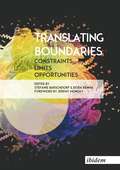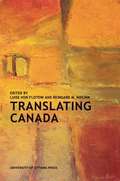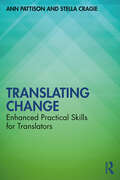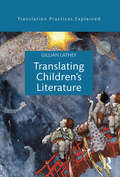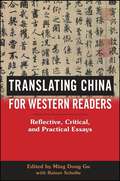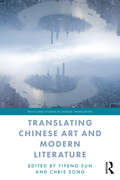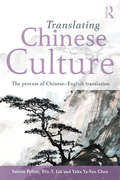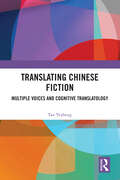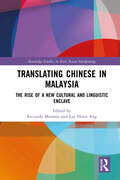- Table View
- List View
Translanguaging in Multilingual English Classrooms: An Asian Perspective and Contexts
by Viniti VaishThis book is the first to apply the theory of translanguaging to multilingual classrooms in an Asian context, offering strategies for teaching specific grammatical and comprehension skills to students struggling to read in English. It also enriches the methodology of coding bilingual transcripts with ideas resulting from a detailed analysis of a large and rich data set. Lastly, the author discusses growth areas in the emerging field of translanguaging and challenges for teachers implementing a translanguaging approach in a superdiverse classroom.
Translanguaging in Science Education (Sociocultural Explorations of Science Education #27)
by Anders Jakobsson Pia Nygård Larsson Annika KarlssonThis edited volume explores diverse translanguaging practices in multilingual science classrooms in Hong Kong, Lebanon, Luxembourg, South Africa, Sweden and the United States. It presents novel opportunities for using students’ home, first or minority languages as meaning-making tools in science education. It also invites to explore the use of language resources and other multimodal resources, such as gestures and body language. In addition, it discusses and problematizes contingent hindrances and obstacles that may arise from these practices within various contexts around the world. This includes reviewing different theoretical starting points that may be challenged by such an approach. These issues are explored from different perspectives and methodological focus, as well as in several educational contexts, including primary, middle, secondary levels, higher education, as well as in after-school programs for refugee teenagers. Within these contexts, the book highlights and shares a range of educational tools and activities in science education, such as teacher-led classroom-talk, language-focused teaching, teachers’ use of meta-language, teachers’ scaffolding strategies, small-group interactions, and computer-supported collaborative learning.
Translanguaging in the Secondary School
by Patricia MertinIn schools across the world, there are large numbers of students who are not native speakers of the language of instruction in their classroom. This leads to challenges for the teachers, students and parents. Translanguaging enables students who are second language leaners to build on previous learning, access the curriculum more effectively, learn with greater depth of understanding, improve their ability to speak and write the academic language of instruction and continue to develop their mother tongue. This book describes the origin and development of translanguaging. It explains the present situation in many secondary schools and the challenges which are faced by teachers, students and their parents. It aligns the power of translanguaging with cognitive psychologists' theories of effective learning. Concrete suggestions are offered to support teaching and learning with real examples from practice given by classroom teachers.
Translanguaging in the Secondary School
by Patricia MertinIn schools across the world, there are large numbers of students who are not native speakers of the language of instruction in their classroom. This leads to challenges for the teachers, students and parents. Translanguaging enables students who are second language leaners to build on previous learning, access the curriculum more effectively, learn with greater depth of understanding, improve their ability to speak and write the academic language of instruction and continue to develop their mother tongue. This book describes the origin and development of translanguaging. It explains the present situation in many secondary schools and the challenges which are faced by teachers, students and their parents. It aligns the power of translanguaging with cognitive psychologists' theories of effective learning. Concrete suggestions are offered to support teaching and learning with real examples from practice given by classroom teachers.
Translanguaging with Multilingual Students: Learning from Classroom Moments
by Ofelia García Tatyana KleynLooking closely at what happens when translanguaging is actively taken up to teach emergent bilingual students across different contexts, this book focuses on how it is already happening in classrooms as well as how it can be implemented as a pedagogical orientation. It extends theoretical understandings of the concept and highlights its promises and challenges. Using a Transformative Action Research design, six empirically grounded ethnographic case studies describe how translanguaging is used in lesson designs and in the spontaneous moves made by teachers and students during specific teaching moments. The cases shed light on two questions: How, when, and why is translanguaging taken up or resisted by students and teachers? What does its use mean for them? Although grounded in a U.S. context, and specifically in classrooms in New York State, Translanguaging with Multilingual Students links findings and theories to different global contexts to offer important lessons for educators worldwide.
Translated Nation: Rewriting the Dakhóta Oyáte
by Christopher J. PexaHow authors rendered Dakhóta philosophy by literary means to encode ethical and political connectedness and sovereign life within a settler surveillance stateTranslated Nation examines literary works and oral histories by Dakhóta intellectuals from the aftermath of the 1862 U.S.–Dakota War to the present day, highlighting creative Dakhóta responses to violences of the settler colonial state. Christopher Pexa argues that the assimilation era of federal U.S. law and policy was far from an idle one for the Dakhóta people, but rather involved remaking the Oyáte (the Očéti Šakówiŋ Oyáte or People of the Seven Council Fires) through the encrypting of Dakhóta political and relational norms in plain view of settler audiences.From Nicholas Black Elk to Charles Alexander Eastman to Ella Cara Deloria, Pexa analyzes well-known writers from a tribally centered perspective that highlights their contributions to Dakhóta/Lakhóta philosophy and politics. He explores how these authors, as well as oral histories from the Spirit Lake Dakhóta Nation, invoke thióšpaye (extended family or kinship) ethics to critique U.S. legal translations of Dakhóta relations and politics into liberal molds of heteronormativity, individualism, property, and citizenship. He examines how Dakhóta intellectuals remained part of their social frameworks even while negotiating the possibilities and violence of settler colonial framings, ideologies, and social forms. Bringing together oral and written as well as past and present literatures, Translated Nation expands our sense of literary archives and political agency and demonstrates how Dakhóta peoplehood not only emerges over time but in everyday places, activities, and stories. It provides a distinctive view of the hidden vibrancy of a historical period that is often tied only to Indigenous survival.
Translated People,Translated Texts
by Tina SteinerTranslated People, Translated Texts examines contemporary migration narratives by four African writers who live in the diaspora and write in English: Leila Aboulela and Jamal Mahjoub from the Sudan, now living in Scotland and Spain respectively, and Abdulrazak Gurnah and Moyez G. Vassanji from Tanzania, now residing in the UK and Canada. Focusing on how language operates in relation to both culture and identity, Steiner foregrounds the complexities of migration as cultural translation. Cultural translation is a concept which locates itself in postcolonial literary theory as well as translation studies. The manipulation of English in such a way as to signify translated experience is crucial in this regard. The study focuses on a particular angle on cultural translation for each writer under discussion: translation of Islam and the strategic use of nostalgia in Leila Aboulela's texts; translation and the production of scholarly knowledge in Jamal Mahjoub's novels; translation and storytelling in Abdulrazak Gurnah's fiction; and translation between the individual and old and new communities in Vassanji's work. Translated People, Translated Texts makes a significant contribution to our understanding of migration as a common condition of the postcolonial world and offers a welcome insight into particular travellers and their unique translations.
Translatin Joyce
by Brian L. Price César A. Salgado John Pedro SchwartzTransLatin Joyce explores the circulation of James Joyce's work in the Ibero-American literary system. The essays address Joycean literary engagements in Spain, Portugal, Argentina, Mexico, and Cuba, using concepts from postcolonial translation studies, antimodernism, game theory, sound studies, deconstruction, and post-Euclidean physics.
Translating across Sensory and Linguistic Borders: Intersemiotic Journeys between Media
by Ricarda Vidal Madeleine CampbellThis book analyses intersemiotic translation, where the translator works across sign systems and cultural boundaries. Challenging Roman Jakobson’s seminal definitions, it examines how a poem may be expressed as dance, a short story as an olfactory experience, or a film as a painting. This emergent process opens up a myriad of synaesthetic possibilities for both translator and target audience to experience form and sense beyond the limitations of words. The editors draw together theoretical and creative contributions from translators, artists, performers, academics and curators who have explored intersemiotic translation in their practice. The contributions offer a practitioner’s perspective on this rapidly evolving, interdisciplinary field which spans semiotics, cognitive poetics, psychoanalysis and transformative learning theory. The book underlines the intermedial and multimodal nature of perception and expression, where semiotic boundaries are considered fluid and heuristic rather than ontological. It will be of particular interest to practitioners, scholars and students of modern foreign languages, linguistics, literary and cultural studies, interdisciplinary humanities, visual arts, theatre and the performing arts.
Translating and Communicating Environmental Cultures (Routledge Studies in Empirical Translation and Multilingual Communication)
by Meng JiEnvironmental translation studies has gained momentum in recent years as a new area of research underscored by the need to communicate environmental concerns and studies across cultures. The dissemination of translated materials on environmental protection and sustainable development has played an instrumental role in transforming local culture and societies. This edited book represents an important effort to advance environmental studies by introducing the latest research on environmental translation and cross-cultural communication. Part I of the book presents the newest research on multilingual environmental resource development based at leading research institutes in Europe, Latin America, North America, and the Asia-Pacific. Part II offers original, thought-provoking linguistic, textual and cultural analyses of environmental issues in genres as diverse as literature, nature-based tourism promotion, environmental marketing, environmental documentary, and children’s reading. Chapters in this book represent original research authored by established and mid-career academics in translation studies, computer science, linguistics, and environmental studies around the world. The collection provides engaging reading and references on environmental translation and communication to a wide audience across academia.
Translating and Interpreting in Australia and New Zealand: Distance and Diversity (Routledge Advances in Translation and Interpreting Studies)
by Judy Wakabayashi and Minako O’HaganThis volume explores Australian and New Zealand experiences of translation and interpreting (T&I), with a special focus on the formative impact of geocultural contexts. Through the critical lenses of practitioners, scholars and related professionals working in and on these two countries, the contributors seek a better understanding of T&I practices and discourses in this richly multilingual and multicultural region. Building on recent work in translation and interpreting studies that extends attention to sites outside of Europe and the Americas, this volume considers the geocultural and geopolitical factors that have helped shape T&I in these Pacific neighbours, especially how the practices and conceptualization of T&I have been closely tied with immigration. Contributors examine the significant role T&I plays in everyday communication across varied sectors, including education, health, business, and legal contexts, as well as in crisis situations, cultural and creative settings, and initiatives to revitalize Indigenous languages. The book also looks to the broader implications beyond the Australian and New Zealand translationscape, making it of relevance to T&I scholars elsewhere, as well as those with an interest in Indigenous studies and minority languages.
Translating and Interpreting in Korean Contexts: Engaging with Asian and Western Others (Routledge Advances in Translation and Interpreting Studies)
by Judy Wakabayashi Ji-Hae KangThe focus of this volume is on how the people of the Korean Peninsula—historically an important part of the Sinocentric world in East Asia and today a vital economic and strategic site—have negotiated oral and written interactions with their Asian neighbors and Europeans in the past and present through the mediation of translators and interpreters. These encounters have been shaped by political, social, and cultural factors, including the shared use of the Chinese writing system in East Asia for many centuries, attitudes toward other Asians and Westerners, and perceptions of Korean identity in relation to these Others. After exploring aspects of historical interactions, the volume addresses how the role and practice of translation and interpreting have recently evolved as a result of the development of digital technology, an increase in the number of immigrants, and changes in political and cultural dynamics in the region. It covers a range of historical and contemporary aspects, genres, and venues that extend beyond the common yet restrictive focus on literary translation and includes discussions of translator training and academic studies of translation and interpreting in Korea.
Translating and Transmediating Children’s Literature (Critical Approaches to Children's Literature)
by Anna Kérchy Björn SundmarkFrom Struwwelpeter to Peter Rabbit, from Alice to Bilbo—this collection of essays shows how the classics of children’s literature have been transformed across languages, genres, and diverse media forms. This book argues that translation regularly involves transmediation—the telling of a story across media and vice versa—and that transmediation is a specific form of translation. Beyond the classic examples, the book also takes the reader on a worldwide tour, and examines, among other things, the role of Soviet science fiction in North Korea, the ethical uses of Lego Star Wars in a Brazilian context, and the history of Latin translation in children’s literature. Bringing together scholars from more than a dozen countries and language backgrounds, these cross-disciplinary essays focus on regularly overlooked transmediation practices and terminology, such as book cover art, trans-sensory storytelling, écart, enfreakment, foreignizing domestication, and intra-cultural transformation.
Translating as a Purposeful Activity: Functionalist Approaches Explained (Translation Theories Explored)
by Christiane NordThis bestselling text is a comprehensive overview of functionalist approaches to translation in English. Christiane Nord, one of the leading figures in translation studies, explains the complexities of theories and terms in simple language with numerous examples. Covering how the theories developed, illustrations of the main ideas, and specific applications to translator training, literary translation, interpreting and ethics, Translating as a Purposeful Activity concludes with a concise review of both criticisms and perspectives for the future. Now with a Foreword by Georges Bastin and a new chapter covering the recent developments and elaborations of the theory, this is an essential text for students of translation studies and for translator training.
Translating Aunt Edna
by Rhonda TelferThree boys decide to play a trick on their aunt, who insists on teaching them new vocabulary words. The English language can be complicated. There are so many words that describe the same thing! You can learn about many of those words in this silly story about a group of siblings who decide they are sick of learning new words!
Translating Borrowed Tongues: The Verbal Quest of Ilan Stavans (Routledge Focus on Translation and Interpreting Studies)
by MªCarmen África Vidal ClaramonteThis book sheds light on the translations of renowned semiotician, essayist, and author Ilan Stavans, elucidating the ways in which they exemplify the migrant experience and translation as the interactions of living and writing in intercultural and interlinguistic spaces. While much has been written on Stavans’ work as a writer, there has been little to date on his work as a translator, subversive in their translations of Western classics such as Don Quixote and Hamlet into Spanglish. In Stavans’ experiences as a writer and translator between languages and cultures, Vidal locates the ways in which writers and translators who have experienced migratory crises, marginalization, and exclusion adopt a hybrid, polydirectional, and multivocal approach to language seen as a threat to the status quo. The volume highlights how the case of Ilan Stavans uncovers unique insights into how migrant writers’ nonstandard use of language creates worlds predicated on deterritorialization and in-between spaces which more accurately reflect the nuances of the lived experiences of migrants. This book will be of particular interest to students and scholars in translation studies, literary translation, and Latinx literature.
Translating Boundaries: Constraints, Limits, Opportunities
by Stefanie Barschdorf Dora RennaTranslation studies have traditionally been known to be interdisciplinary. What better term to sum this up than boundaries? A term that means different things in different fields and can be applied to a multitude of topics. Political, personal, symbolic, or professional boundaries, boundaries of the mind as found in psychology, or boundaries in the sociological sense where they separate different fields of knowledge. From politics to geography, boundaries are everywhere. They need to be identified, drawn, or overcome—depending on circumstances and context. What are the boundaries translators and interpreters have to deal with? How do they relate to translation studies in general? Boundaries and translation go hand in hand. As the discipline grows and ever more elements of interdisciplinarity come into play, the more the question of what the boundaries of translation are needs to be asked. Some of the research topics presented in this collection may well extend the boundaries of the discipline itself, while others may look at the constraints and limits under which translators and translations operate, or showcase the role translation and interpreting play in overcoming social or political boundaries.It is with this in mind that the group of young researchers presented in this book has come together. The papers offer insights into the state of the discipline in various nations, often touching on underresearched topics such as the role of translation in the creation of national as well as individual identities or the translation of popular music. They look at the role of culture and, more specifically, sociocultural influences on translation. At the same time, non-linguistic, intra- and extratextual factors are taken into account with particular attention to multimodality. What unites the papers collected is the general tendency to see translation as a means of bringing people together and enabling dialogue, a means of overcoming ideological and social boundaries. By looking both to the past and the future of the discipline, the authors aim to (re)define the boundaries of translation studies.
Translating Canada (Perspectives on Translation)
by Luise Von Flotow Reingard M. NischikIn the last thirty years of the twentieth century, Canadian federal governments offered varying degrees of support for literary and other artistic endeavour. A corollary of this patronage of culture at home was an effort to make the resulting works available for audiences elsewhere in the world. Current developments in the study of translation and its influence as cultural transfer have made possible new assessments of such efforts to project a national image abroad. Translating Canada examines cultural materials exported by Canada in addition to those selected for acquisition by German publishers, theatres, and other culture brokers. It also considers the motivations of particular translators and the reception by German reviewers of works by a wide variety of Canadian writers -- novelists and poets, playwrights and children's authors, literary and social critics. Above all, the book maps for its readers a number of significant, though frequently unsuspected, roles that translation assumes in the intercultural negotiation of national images and values. The chapters in this collection will be of value to students, teachers, and scholars in a number of fields. Informed lay readers, too, will appreciate the authors’ insights into the different ways in which translation has contributed to German reception of Canadian books and culture.
Translating Change: Enhanced Practical Skills for Translators
by Ann Pattison Stella CragieTranslating Change explores and analyses the impact of changes in society, culture and language on the translation and interpreting process and product. It looks at how social attitudes, behaviours and values change over time, how languages respond to these changes, how these changes are reflected in the processing and production of translations and how technological change and economic uncertainty in the wake of events such as the COVID-19 pandemic and Brexit affect the translation market. The authors examine trends in language change in English, French, German, Italian and Spanish. The highly topical approach to social, cultural and language change is predominantly synchronic and pragmatic, based on tracking and analysing language changes and trends as they have developed and continue to do so. This is combined with an innovative section on developing transferable translation-related skills, including writing and rewriting, editing, abstracting, transcreation and summary writing in view of a perceived need to expand the skills portfolio of translators in a changing market and at the same time to maximise translation quality. Each chapter features Pause for Thought/activity boxes to encourage active reader participation or reflection. With exercises, discussion questions, guided further reading throughout and a glossary of key terms, this innovative textbook is key reading for both students and translators or interpreters, in training and in practice.
Translating Children's Literature (Translation Practices Explained)
by Gillian LatheyTranslating Children’s Literature is an exploration of the many developmental and linguistic issues related to writing and translating for children, an audience that spans a period of enormous intellectual progress and affective change from birth to adolescence. Lathey looks at a broad range of children’s literature, from prose fiction to poetry and picture books. Each of the seven chapters addresses a different aspect of translation for children, covering: · Narrative style and the challenges of translating the child’s voice; · The translation of cultural markers for young readers; · Translation of the modern picture book; · Dialogue, dialect and street language in modern children’s literature; · Read-aloud qualities, wordplay, onomatopoeia and the translation of children’s poetry; · Retranslation, retelling and reworking; · The role of translation for children within the global publishing and translation industries. This is the first practical guide to address all aspects of translating children’s literature, featuring extracts from commentaries and interviews with published translators of children’s literature, as well as examples and case studies across a range of languages and texts. Each chapter includes a set of questions and exercises for students. Translating Children’s Literature is essential reading for professional translators, researchers and students on courses in translation studies or children’s literature.
Translating China for Western Readers: Reflective, Critical, and Practical Essays (SUNY series in Chinese Philosophy and Culture)
by Ming Dong Gu; Rainer SchulteThis book explores the challenges of translating Chinese works, particularly premodern ones, for a contemporary Western readership. Reacting against the "cultural turn" in translation studies, contributors return to the origin of translation studies: translation practice. By returning to the time-honored basics of linguistics and hermeneutics, the book inquires into translation practice from the perspective of reading and reading theory. Essays in the first section of the work discuss the nature, function, rationale, criteria, and historical and conceptual values of translation. The second section focuses on the art and craft of translation, offering practical techniques and tips. Finally, the third section conducts critical assessments of translation policy and practice as well as formal and aesthetic issues. Throughout, contributors explore how a translation from the Chinese can read like a text in the Western reader's own language.
Translating Chinese Art and Modern Literature (Routledge Studies in Chinese Translation)
by Yifeng Sun Chris SongTranslating Chinese Art and Modern Literature examines issues in cross-cultural dialogue in connection with translation and modern Chinese art and literature from interdisciplinary perspectives. This comprises the text-image dialogue in the context of Chinese modernity, and cross-cultural interaction between modern literature in Chinese and other literatures. This edited collection approaches these issues with discrete foci and approaches, and the ten chapters in this volume are to be divided into two distinct parts. The first part highlights the mutual effects between literary texts and visual images in the media of book, painting, and film, and the second part includes contributions by scholars of literary translation.
Translating Chinese Culture: The process of Chinese--English translation
by Valerie Pellatt Eric T. Liu Yalta Ya-Yun ChenTranslating Chinese Culture is an innovative and comprehensive coursebook which addresses the issue of translating concepts of culture. Based on the framework of schema building, the course offers helpful guidance on how to get inside the mind of the Chinese author, how to understand what he or she is telling the Chinese-speaking audience, and how to convey this to an English speaking audience. A wide range of authentic texts relating to different aspects of Chinese culture and aesthetics are presented throughout, followed by close reading discussions of how these practices are executed and how the aesthetics are perceived among Chinese artists, writers and readers. Also taken into consideration are the mode, audience and destination of the texts. Ideas are applied from linguistics and translation studies and each discussion is reinforced with a wide variety of practical and engaging exercises. Thought-provoking yet highly accessible, Translating Chinese Culture will be essential reading for advanced undergraduates and postgraduate students of Translation and Chinese Studies. It will also appeal to a wide range of language studies and tutors through its stimulating discussion of the principles and purposes of translation.
Translating Chinese Fiction: Multiple Voices and Cognitive Translatology
by Tan YeshengDrawing on the cognitive translatological paradigm, this book introduces a situation-embedded cognitive construction model of translation and explores the thinking portfolios of British and American sinologists-cum-translators to re-examine their multiple voices and cognition in translating Chinese fiction.By placing sinologists-cum-translators in the same discourse space, the study transcends the limitations of previous case studies and offers a comprehensive cognitive panorama of how Chinese novels are rendered. The author explores the challenges and difficulties of translating Chinese fiction from the insider perspectives of British and American sinologists, and cross-validates their multiple voices by aligning them with cross-cultural communication scenarios. Based on the cognitive construction model of translation, the book provides a systematic review of the translation thoughts and ideas of the community of sinologists in terms of linguistic conventions, narrative styles, contextual and cultural frames, readership categories and metaphorical models of translation. It envisions a new research path to enhance empirical research on translators' cognition in a dynamic translation ecosystem. The title will be an essential read for students and scholars of translation studies and Chinese studies. It will also appeal to translators and researchers interested in cognitive stylistics, literary studies and intercultural communication studies.
Translating Chinese in Malaysia: The Rise of a New Cultural and Linguistic Enclave (Routledge Studies in East Asian Interpreting)
by Riccardo Moratto Lay Hoon AngShedding light on the nuances of cross-cultural communication, this edited volume offers insights into how Chinese Malaysians, a major ethnic group, navigate the complexities of translating across diverse languages.This book unveils the unique landscape of translation from Chinese in Malaysia, where the emphasis lies not just in theoretical nuances but in the practical application of bridging linguistic divides. The narrative unfolds the dedicated efforts of the local Chinese community, passionately engaged in translating literary gems and unraveling language intricacies. It provides a platform to explore how Chinese Malaysians use translation as a tool to maintain and transmit their linguistic and cultural legacy. By highlighting specific works and creative endeavours, the authors showcase the unique contributions of the Chinese community to the broader field of translation, fostering an appreciation for the cultural and artistic dimensions embedded in the translated texts.This book serves as an educational tool for students, scholars, and researchers interested in translation studies and multiculturalism. It also provides a comprehensive exploration of the challenges and opportunities faced by Chinese translators in Malaysia, encouraging further research and fostering a deeper understanding of the field.
